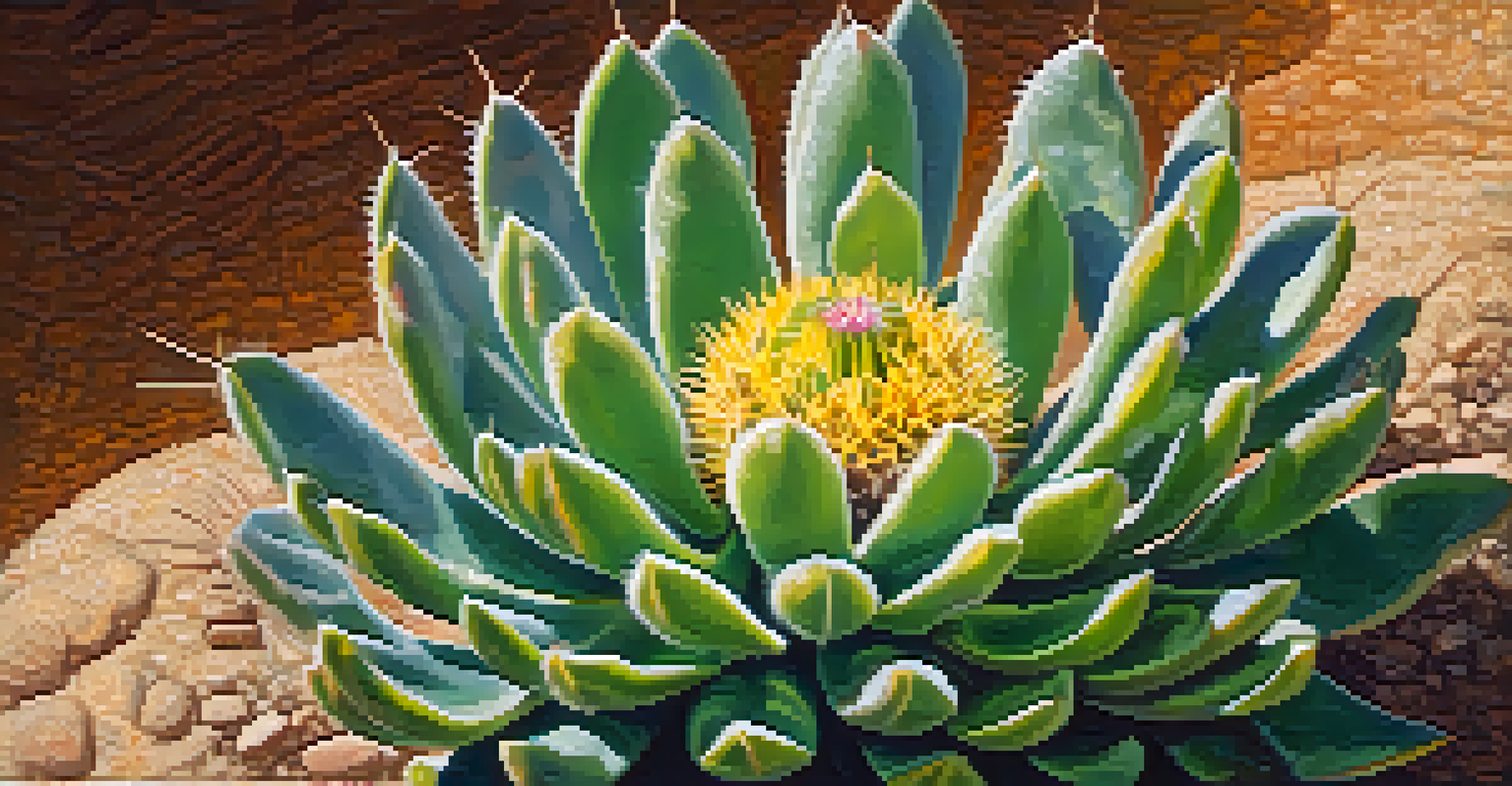The Role of Peyote in Indigenous Mexican Traditions

Introduction to Peyote and Its Cultural Context
Peyote, a small cactus native to Mexico and the southwestern United States, has been a cornerstone in Indigenous Mexican traditions for centuries. Known scientifically as Lophophora williamsii, it contains mescaline, a psychoactive compound that plays a significant role in spiritual practices. For many Indigenous communities, peyote is more than just a plant; it’s a sacred symbol of connection to the divine and the natural world.
Peyote is not just a plant; it is a sacred symbol of connection to the divine and the natural world.
In these cultures, the use of peyote is deeply intertwined with their history, spirituality, and identity. It’s often utilized in traditional ceremonies, where its effects are believed to facilitate communication with ancestors and the spirit world. By understanding the cultural context of peyote, we can appreciate its significance beyond mere recreational use.
The reverence for peyote is reflected in the rituals and ceremonies that surround its consumption, often emphasizing respect for the earth and gratitude for its gifts. This holistic view promotes a balance between mind, body, and spirit, highlighting the importance of peyote in fostering community and cultural continuity.
Historical Use of Peyote Among Indigenous Peoples
The historical use of peyote dates back thousands of years, with evidence suggesting that it has been utilized since at least 5000 BCE. Indigenous peoples, including the Huichol, Tarahumara, and various Apache groups, have incorporated peyote into their spiritual and cultural practices for generations. Archaeological findings, such as peyote-related artifacts, underscore its significance in ancient societies.

Traditionally, peyote was used during rituals to seek guidance, healing, and insight. The experience induced by peyote is often described as transformative, allowing participants to gain a deeper understanding of their lives and the world around them. This historical narrative illustrates the profound connection between peyote and the spiritual practices of Indigenous cultures.
Peyote's Sacred Cultural Role
Peyote is a vital symbol in Indigenous traditions, representing a deep spiritual connection and cultural identity.
As colonialism and modernization began to encroach on Indigenous lands, the traditional use of peyote faced challenges. However, many Indigenous communities have preserved these practices, adapting them to contemporary contexts while maintaining their cultural integrity. This resilience speaks volumes about the enduring importance of peyote in their traditions.
Peyote in Ceremonial Practices
Ceremonies involving peyote often serve as communal gatherings where participants seek healing, guidance, and spiritual nourishment. The most well-known of these ceremonies is the Native American Church service, which blends Christianity with Indigenous beliefs, using peyote as a sacrament. During these ceremonies, participants consume peyote under the guidance of a spiritual leader, fostering a safe and respectful environment.
The continued use of peyote in ceremonies stands as a testament to the resilience of Indigenous communities and their commitment to preserving their traditions.
The effects of peyote typically include vivid visions, introspection, and a heightened sense of connection to nature and the universe. These experiences are often seen as opportunities for personal growth and healing. Participants report feelings of unity with others and a deeper understanding of their place in the world, reinforcing the communal aspect of the ceremony.
Additionally, these ceremonies emphasize the importance of preparation and integration. Participants are encouraged to approach peyote with respect and intention, often engaging in prayer and meditation before and after the experience. This holistic approach ensures that the insights gained during the ceremony can be woven into daily life, enhancing personal and communal well-being.
Cultural Significance Beyond Spirituality
The significance of peyote extends beyond its spiritual use; it also plays a vital role in the cultural identity of Indigenous communities. The rituals surrounding peyote reinforce social bonds and shared values, fostering a sense of belonging among participants. Through these communal experiences, individuals connect with their cultural heritage and transmit traditions to future generations.
Moreover, peyote serves as a symbol of resistance against colonial forces that have sought to erase Indigenous cultures. The continued use of peyote in ceremonies stands as a testament to the resilience of these communities and their commitment to preserving their traditions. This cultural significance is not only about maintaining practices but also about asserting identity and autonomy.
Historical Resilience of Practices
Despite challenges from colonialism, Indigenous communities have preserved and adapted peyote rituals, showcasing their cultural resilience.
In this way, peyote embodies a rich tapestry of meanings that encompasses spirituality, community, and cultural resilience. Its role in Indigenous traditions highlights the importance of recognizing and respecting these practices as vital expressions of identity in a rapidly changing world.
Legal and Ethical Considerations Surrounding Peyote
The legal status of peyote is complex and varies significantly across different regions. In the United States, for instance, its use is protected for members of the Native American Church, allowing them to incorporate it into their spiritual practices. However, outside of this context, peyote remains classified as a Schedule I controlled substance, complicating access for others interested in its traditional uses.
This legal framework raises important ethical questions about cultural appropriation and the commercialization of peyote. As interest in psychedelics grows, there is a risk that the cultural significance of peyote may be overshadowed by trends in recreational use. It becomes essential to respect the traditions of Indigenous peoples and to engage with peyote in a manner that honors its sacred status.
Advocacy for Indigenous rights and autonomy is crucial as discussions around peyote continue to evolve. Supporting Indigenous-led initiatives and respecting their practices can help ensure that peyote is used in ways that are culturally sensitive and ethically sound. In this regard, understanding the legal and ethical landscape surrounding peyote is vital for anyone interested in its rich traditions.
Contemporary Perspectives on Peyote
In recent years, there has been a resurgence of interest in peyote, both within Indigenous communities and among a broader audience. This revitalization often seeks to bridge traditional practices with contemporary spiritual and psychological exploration. Many individuals are drawn to peyote for its potential therapeutic benefits, particularly in addressing mental health issues like anxiety and depression.
However, it is important to approach this interest with caution and respect. For Indigenous peoples, peyote is a sacred plant that carries significant cultural weight, and its use should not be trivialized. Engaging in respectful dialogue with Indigenous communities is crucial for fostering understanding and ensuring that their voices are prioritized in discussions about peyote’s role in modern society.
Legal and Ethical Considerations
The legal status of peyote raises ethical concerns about cultural appropriation, highlighting the need to respect Indigenous practices.
Additionally, there is a growing conversation about the sustainability of peyote harvesting as demand increases. Ethical sourcing and cultivation practices are essential to ensure that this sacred plant remains available for future generations. By balancing contemporary interests with traditional values, we can honor the significance of peyote while promoting its responsible use.
Conclusion: Honoring the Legacy of Peyote
The role of peyote in Indigenous Mexican traditions is multifaceted, encompassing spiritual, cultural, and ethical dimensions. As we explore the significance of this ancient plant, it becomes clear that its use is rooted in deep respect for nature, community, and identity. By appreciating these layers of meaning, we can foster greater understanding and respect for Indigenous practices.
Honoring the legacy of peyote involves acknowledging its historical roots, supporting Indigenous rights, and engaging in responsible practices. As society continues to grapple with the complexities of peyote's use, it's crucial to prioritize Indigenous perspectives and ensure their traditions are respected. This approach not only benefits Indigenous communities but enriches our collective understanding of spirituality and connection.

Ultimately, peyote serves as a reminder of the importance of cultural heritage and the need for respectful engagement with traditions that have shaped human experience for millennia. By embracing the lessons offered by peyote, we can cultivate a deeper appreciation for the diverse tapestry of human spirituality and the wisdom of Indigenous cultures.